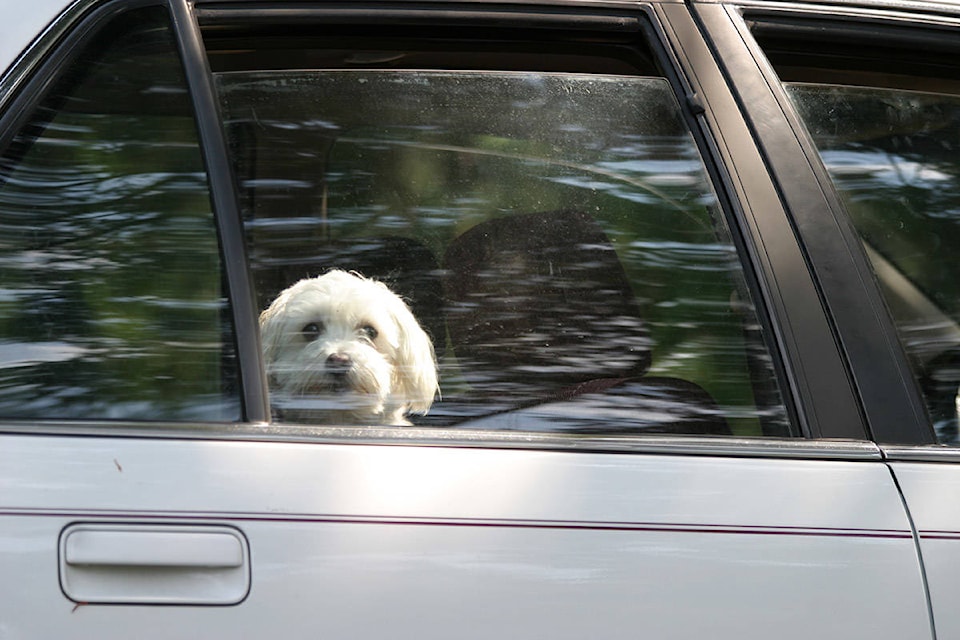The BC SPCA and a crime prevention society are reminding drivers about the dangers of pets in vehicles.
And they’re not just speaking about how hazardous it can be to leave a pet inside a parked car in summer, but also when travelling.
Not only can unsecured pets cause a distraction for drivers, but in the event of a crash a loose animal can fly forward in a vehicle, causing injury to themselves and to others in the vehicle, said Michael Drewery, speed and city watch coordinator for Chilliwack Crime Prevention Society.
RELATED:
“Many people consider their pets as part of the family,” said Chloe MacBeth, manager of the BC SPCA in Chilliwack. “And as with any loved one who rides in your vehicle, we hope drivers will take steps to keep their dog or cat seated, secure and safe during every drive.”
The BC SPCA recommends always using some form of safety restraint whenever travelling with a pet, even for mild-mannered pets or when running a quick errand around town.
Pet harnesses/safety belts and secured, hard-shell crates are the best options when transporting animals, adds MacBeth.
Harnesses come in various sizes to fit your dog. Make sure the harness fits properly and is easy to put on. A rule of thumb is to leave an allowance for two fingers to fit between the harness and your pup for a comfortable fit. Dogs should be able to stand, sit, or lay down comfortably, without having to brace themselves while you’re turning, reversing or stopping.
If you’re using a crate, it must be secured by a seatbelt, cargo hooks, or placed by the rear seat to secure it in place. If unsecured, the crate can bounce around and even become a projectile. When you’re buying a crate for your dog, look for one that has been crash-tested.
For cats, the BC SPCA recommends “airline type” (not cardboard) cat travel carriers. A sturdier carrier will protect your cat from escaping and from injury in the event of a crash. Help your cat learn to love their carrier before your first trip by offering treats, food, and a familiar blanket inside and gradually encouraging them to hang out in the carrier.
The BC SPCA offers these safety tips for pets and vehicles:
• Use a safety device to protect your pet. Loose animals in the event of crash can become a projectile in the vehicle. Animals can also pose a safety risk for first responders, as a disoriented and injured animal may try to attack an attendant or even cause another crash by running into traffic
• Let your dog be the backseat driver. Pets are safest when secured in the back seat or cargo area
• Keep pets inside the vehicle while driving. While it’s tempting to let your dog hang his head out the window for the breeze, the sand and dust can get in their eyes and cause corneal ulcers. Disable your power windows to prevent your dog from accidentally opening a window, causing it to escape or have the window close on its neck
• Do not drive with your pet on your lap. This can prevent you from having full control of your vehicle. Your pet could also be seriously injured or killed by a deployed airbag in the event of a crash. Drivers can be ticketed for driving with ‘without due care and attention’
• Secure your pet if travelling in the back of a pick-up truck. It is illegal and dangerous to travel with an unsecured pet in the exterior of a truck. If you must transport your pet in the back of a truck, the safest method is in a secured crate in the centre of your truck box
• If you’re not in the car, your dog shouldn’t be either. Vehicles can quickly heat up in summer weather, and can endanger your pet’s health. Even a car parked in the shade with the windows cracked open can get hot enough to cause heatstroke or death of an animal
RELATED:
Do you have something to add to this story, or something else we should report on?
Email: jenna.hauck@theprogress.com
Twitter:
Like us on and follow us on .



